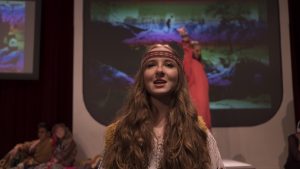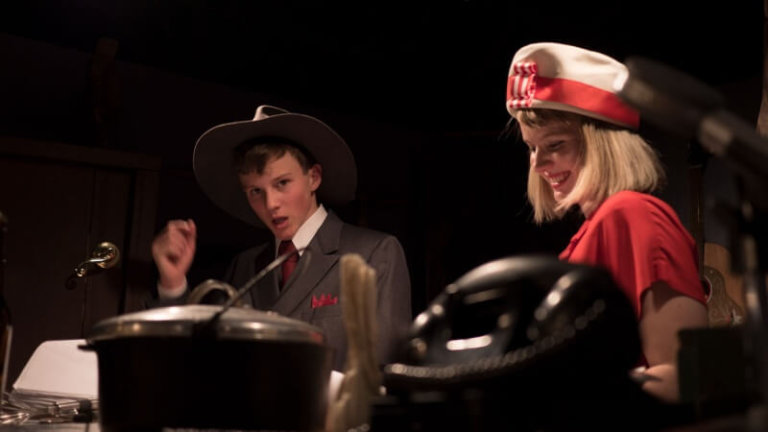 Last trimester, a theater colleague and I were honored to be invited to the Upper School’s Gender Studies classes to speak to students in preparation for their attendance at our season’s opening rep productions of David Mamet’s American Buffalo, and Girls Like That, by Evan Placey. I realized that, beyond trying to engender excitement about seeing some live peer-theater, what we were actually doing was giving students a way of seeing, not an analysis or our directorial interpretations, but rather an approach to developing an artistic vision connected to their own thoughts and experiences, as well as to what they would witness on stage. What is undeniable about the arts is that they enrich us every single day, because they provide an infinite lens for seeing what it means to be alive — now, before, and in the future — and, the composite experience is always something beyond what is staid or common.
Last trimester, a theater colleague and I were honored to be invited to the Upper School’s Gender Studies classes to speak to students in preparation for their attendance at our season’s opening rep productions of David Mamet’s American Buffalo, and Girls Like That, by Evan Placey. I realized that, beyond trying to engender excitement about seeing some live peer-theater, what we were actually doing was giving students a way of seeing, not an analysis or our directorial interpretations, but rather an approach to developing an artistic vision connected to their own thoughts and experiences, as well as to what they would witness on stage. What is undeniable about the arts is that they enrich us every single day, because they provide an infinite lens for seeing what it means to be alive — now, before, and in the future — and, the composite experience is always something beyond what is staid or common.
As a child I owned a contraption called a View-master®. I loved this toy. You looked through it as putting binoculars to your face, and slipped in a round card with tiny slides. I spent hours lying on my bed, pointing this device to the light so I could study the stories in all their detail, the random hairs on an ogre’s head, the shades of green in a forest, and, best of all, the 3-D pop out of a lane, with weeping trees, rambling through a flowered meadow far away from where the people stood, up close and personal.
Daniel Birnbaum, Curator for the 53rd Venice Biennale writes, “A work of art is more than an object, more than a commodity. It represents a vision of the world, and, if taken seriously, it can be seen as a way of world-making.” When I read this statement, I immediately thought of my childhood toy. Yes, the View-Master® was moreof a commodity than a work of art — everyone who was anyone owned one — but it did afford me a unique perspective of my world, as well as an introduction to what would become a life-long obsession with seeking experiences through images and sounds in all forms. And while I bristle when I see people in a gallery asking to see a painting with some “blue” to match their sofa, I trust that Birnbaum’s assertion is true, that if art is taken seriously, it holds the power to be world-making.
Learning to take art seriously is a deliberate choice and an essential part of our students’ education at CA. A student taking her first drawing class may be, in approach, as serious as the most advanced portfolio student. A Conservatory dancer who heeds every instruction and correction, striving to become excellent, certainly has linked into what is serious about the study.
Yet, by the same token, individuals who may not engage hands-on in the arts are often the most serious of art patrons in that they seek opportunities to witness, understand, and appreciate the connective perspective the arts give us for navigating our daily lives and for helping us construct a better world.
I see this world-making happening on our campus daily. There is the Sixth Grade student who asked me to sit next to him and “watch me” as he recorded a presentation on surrealism by one of his peers. There is the Lower School student who skips out of the music room in Schotters, practicing the song she just learned with a friend all the way to her next class. There are the Upper School advanced actors in the dressing room re-working the lines of a scenic moment before performance. There are also the many parents and colleagues, who come up to me after a production in all divisions at CA, and tell me that they are blown away by what our students have presented, by what they are feeling as a result, and best of all, they continue to to ask questions, to hold discussions with others as they process the world-making power of their collective artistic experience.
This is important stuff. If we, as parents and educators, teach our students to give true weight to the artistic experience, to see it as serious, so to speak, the arts will become significant tools for the making of their future world, a world that depends upon them, a world that needs them, and a world that craves their vision and confidence.
As we move through these winter months, feel free to come across campus to the art building and observe the expanse of projects our students are creating, from the very youngest to our seniors busy with their portfolios. See the drawings of a number of advanced artists who are working with our Mock Trial lawyers to produce authentic courtroom sketches. Listen to the ever-changing repertoire in the choir, band and orchestra rooms as well as in the Lower School music classes, or, take in the second annual 24-Hour Play Project in January. Also, don’t miss the second trimester productions of Eurydice and the Dance Company’s annual In Concert ’18, both in February.
While art instruction at CA is challenging and honest in assessment, it is not judgmental, but rather open, sincere, and generous. What is serious about the arts at CA is that they are encouraged rather than enforced, inspired rather than defined, and, that students are urged to find paths of connection, observation, and participation that ring true for them. After all, our children are much more than a commodity. They are uncommon and invigorating human beings, and, they are the world-makers of the future.
